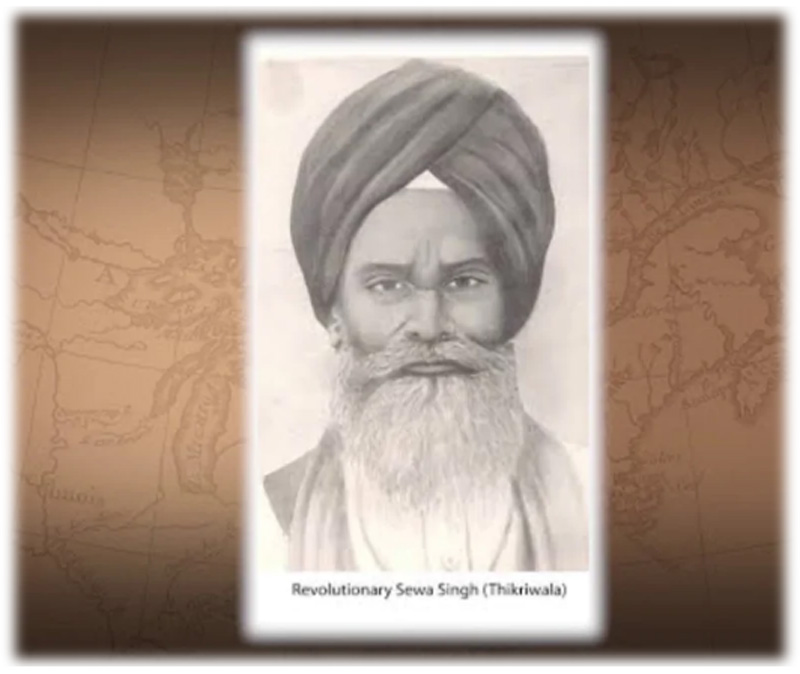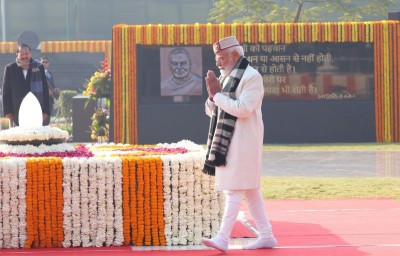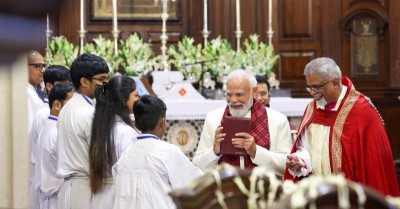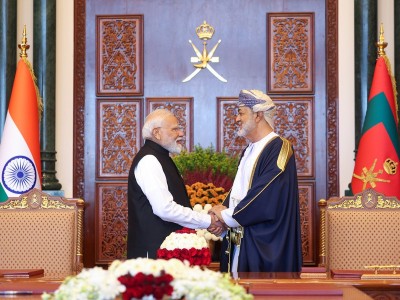 Sewa Singh Theekriwala
Sewa Singh Theekriwala
Indian freedom movement: Remembering Sewa Singh Theekriwala
Earlier this month was the birth anniversary of Sewa Singh Theekri Wala – the hero of the Punjab Riyasti Praja Mandal movement (Self-Rule Movement in the Princely States) in Punjab against the despotic rules of the Punjab State rulers.
The Punjab Riyasti Praja Mandal was affiliated to the All India States People`s Conference then fighting for the self-rule and rights of the people living in 600 British crown supported princely states in India.
Like the Akali Dal fighting for the emancipation of Gurudwaras from the British crown supported Mahants in Punjab, the Punjab Riyasti Praja Mandal movement gained appreciation and support from the mainstream leaders of the national freedom movement.
The freedom movement against the imperial rule by the British in India was multi-layered but only the mainstream in the public knowledge: there was fight against the local rulers in the princely states who were extended support by the British India government as a part of the British policy and agreement.
That is why, as a sequel to the political activities in the then Indian princely states, the present day CRPF was raised by the crown representative of the British Empire help the princely states contain unrest there.
Established in 1939 as the Crown’s Representative Police was renamed as the CRPF by the act of Parliament in 1949.
One layer of the freedom movement against the British India government, being what is called the mainstream movement, there were other movements on the side lines against the British supported and patronised Indian Princes and the heads of religious institutions such as the Mahants in Punjab.
Since all of them were fighting for their emancipation from the autocracy, misrule and mismanagement and their civil and legitimate rights, they often cut across the side lines and the mainstream.
Thus from the 1920s the Praja Mandal movement popular in princely states where the people were directly subject to the rule of local aristocrats called Rajas, Maharajas and Nawabs but indirectly to the British government in India shared its concerns and synchronised with the national independence movement in India.
The leaders of the Parja Mandal campaigned against their feudal rulers and also the British administration fighting for their civil rights.
It was just before or soon after the independence in 1947 when the movements on the side lines, which were actually the mainstream movements in their domains, were covered and forgotten by the mainstream movement exponents.
However, their role in the freedom movement was no less than the mainstream movement; in reality the sufferings of their leaders outweigh the sufferings of the mainstream leaders. The founder and the first president of the Punjab Riyasati Praja Mandal should not remain in oblivion but be remembered by us with respect equal to the mainstream leaders of the freedom movement.
With the initiative and support from the then Akali workers and other right thinking individuals fighting for freedom, the formation of the Punjab Riyasti Praja Mandal- people’s organisation/ group in the princely states in the region of Punjab, was formed on September 17, 1927 and announced at a congregation at the Mansa town, then in the Patiala state and now in the Sangrur district on 17 July 1928. The Praja Mandal movement was a revolt against both colonial rule by the British and the feudal rule by the Indian Princes with patronage from the British government in India.
Born on August 24, 1882 in the Thikriwala village near Barnala town in the then Patiala State and the present Sangrur district, the child Sewa Singh studied in Patiala because his father was a high-ranking official at Maharaja Rajinder Singh’s court in Patiala. After his education and study of Urdu, Persian, Punjabi, and English languages, Sewa Singh was also appointed as a State official yet he spent his time working on the Singh Sabha movement for reforms and revival of Sikh values.
Influenced by the events of Jallian Wala Bagh massacre in 1919 against the repressive Rowlatt Acts by the British India government, Saka (massacre) Nankana Sahib in 1921, Guu Ka Bagh Morcha in 1922 and Jaito Morcha in 1923 against the British India government supported corrupt priests called Mahants in the Sikh shrines (Gurudwaras) and the acts of despotism in the Patiala and other Princely states in Punjab, he devoted himself to awaken the people for their rights, dignity and freedom. In 1923 he was arrested and detained in the Lahore jail for three years. Being opposed to despotism and autocratic rule by the British supported Indian princes squandering the state wealth on personal luxuries, he developed trouble with the rulers of the Patiala State. When released in 1926 from the Lahore jail, he was rearrested on a false charge of a minor theft which could not be proved, yet he was kept in jail for another three years. While he was still in jail in a false sedition case, Sewa Singh Thikri wala was elected the founder president of the Punjab Riyasti Praja Mandal in its congregation on July 17, 1928.
The then Patiala state ruler Maharaja Bhupinder Singh received strong denunciation from the Akali leader Baba Kharak Singh who demanded immediate release of the Sewa Singh Theekri Wala. In protest against the bad behaviour of the jail authorities, Sewa Singh went on hunger strike. When his condition grew critical, he was released under pressure. Immediately after his release he pursued the Praja Mandal agenda passionately.
The first formal session of the Punjab Riyasti Praja Mandal after its inception was held on December 27, 1929 at Lahore where a resolution condemning the inefficient administration of Maharaja Bhupinder Singh was adopted.
A memorandum on the misrule in the Patiala state was sent to the Viceroy of India and the Maharaja was found guilty of most charges in an enquiry conducted by the All India States People`s Conference. At another conference held on October11, 1930 in Ludhiana, Maharaja Bhupinder Singh was severely criticised for his misrule.
Sensing the popularity of the Praja Mandal movement in the State, in 1931, Maharaja Bhupinder Singh invited Sewa Singh for negotiations which fizzled out over his demand for an elected assembly in the State. In the same year the annual conference of the Punjab Riyasati Praja Mandal was held in Shimla where he met Mahatma Gandhi and discussed the problems of the people of the Patiala State.
Following that in 1931 the Hidayat (instruction) banning all political activity was issued by the Patiala State to contain the Praja Mandal activities in the state. But the popularity of the Praja Mandal movement under the leadership of Sewa Singh Theekri Wala continued to rise and it launched an aggressive campaign against the Patiala ruler, demanding his deposition.
Sewa Singh Theekri Wala participated in the farmers’ agitation in Jind in 1931 and Malerkotla in 1932. He also launched a newspaper named ‘Kaumi Dard’ to spread the principles of Sikh religion and raise the voice against atrocities on it.
In 1933 Seva Singh was arrested by the Patiala police and sentenced to imprisonment. Protesting against the ill treatment in the jail, he went on hunger strike. As the jail authorities did not pay much attention to his demands and deteriorating health, he died on 19 January 1935.
The history of the freedom movement of the present India has not been the same at all times and in all its parts; it is, in reality, a layered history accumulating many narratives of protest and suffering over time with some more apparent and the others underneath.
It is necessary to uncover and articulate those underneath for all the due acknowledgement of what the individuals and the movements delivered.
Support Our Journalism
We cannot do without you.. your contribution supports unbiased journalism
IBNS is not driven by any ism- not wokeism, not racism, not skewed secularism, not hyper right-wing or left liberal ideals, nor by any hardline religious beliefs or hyper nationalism. We want to serve you good old objective news, as they are. We do not judge or preach. We let people decide for themselves. We only try to present factual and well-sourced news.







